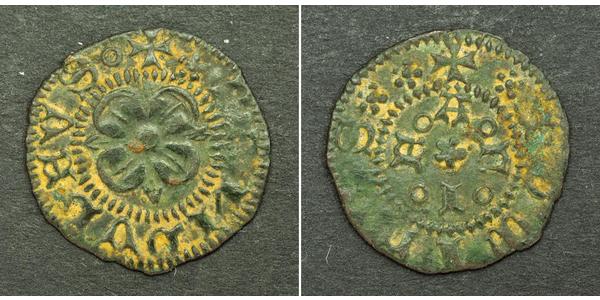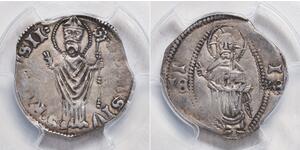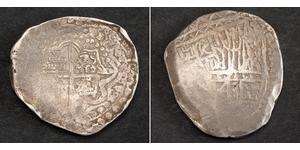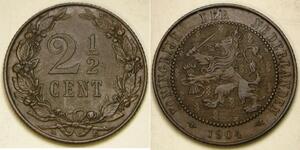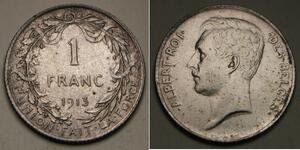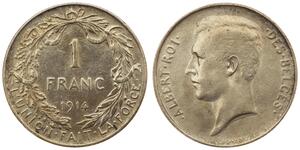(sold for $68.0)
1384, Italian States, Fano (Lordship), Pandolfo III Malatesta. Cu Piccolo Coin. Rare!
Mint Place: Fano State: Fano (Lordship) Denomination: Piccolo Mint Period: 1384-1417 AD Ruler: Pandolfo III Malatesta (Condottiero & Lord of Fano) Reference: CNI 1/14, Ciavaglia 1. Very rare in this condition and without severe corrosion! Condition: Minor deposits, othewrise a nice XF-AU (for type!) with beautiful glossy green patina! Material: Copper Diameter: 14mm Weight: 0.44gm
Obverse: Cewntral flower with four large round pettels and four small and sharp ones. All within inner circle. Legend: + * PANDVLFVS ° Reverse: Four letters ( F ° A ° N ° I ° ) around central rosette, split by annullets. All within inner circle. Legend: + * DOMINVS * *
Condottieri (singular condottiero or condottiere) were Italian military leaders involved in classical formation battles, first as mercenary captains commanding free companies and later as generals of multi-national armies. In medieval Italian, condottieromeant "contractor" but the term later acquired the broader meaning of "military leader", also in reference to Italian Catholics serving as commanders for the Roman Catholic side during the Counter-Reformation (e.g. "Condottiero Alexander Farnese").
Fano is a town and comune of the province of Pesaro and Urbino in the Marcheregion of Italy. It is a beach resort 12 kilometres (7 miles) southeast of Pesaro, located where the Via Flaminia reaches the Adriatic Sea. It is the third city in the region by population after Ancona and Pesaro.
An ancient town of Marche, it was known as Fanum Fortunae after a temple of Fortuna located there. Its first mention in history only dates from 49 BC, when Julius Caesar held it, along with Pisaurum and Ancona. Caesar Augustus established a colonia, and built a wall, some parts of which remain. In 2 AD Augustus also built an arch (which is still standing) at the entrance to the town.
In January 271, the Roman Army defeated the Alamanni in the Battle of Fano that took place on the banks of the Metauro river just inland of Fano.
Fano was destroyed by Vitiges' Ostrogoths in AD 538. It was rebuilt by the Byzantines, becoming the capital of the maritime Pentapolis("Five Cities") that included also Rimini, Pesaro, Senigallia and Ancona. In 754 it was donated to the Popes by the Frank kings.
The Malatesta became lords of the city in 1356 with Galeotto I Malatesta, who was nominally only a vicar of the Popes. Among the others, Pandolfo III resided in the city. Under his son, the famous condottiero Sigismondo Pandolfo Malatesta, Fano was besieged by Papal troops under Federico III da Montefeltro, and returned to the Papal administration. It was later part of the short-lived state of Cesare Borgia, and then part of the duchy of the della Roveres in the Marche.
During the Napoleonic Wars it suffered heavy spoliations; the city had an active role in the Risorgimento. In World War I Fano was several times bombed by the Austro-Hungarian Navy. During World War II it was massively bombed by Allied airplanes due to hit the strategic railway and street bridges crossing the Metauro river, suffering also the destruction of all its bell towers by the Nazi occupation troops when they withdrew.
Buy with confidence!
Pandolfo III Malatesta (c. 1369 – October 3, 1427) was an Italian condottiero and lord of Fano, a member of the famous House of Malatesta.
He was the second son of Galeotto I Malatesta. After the latter's death, the Malatesta lands were divided: he received Fano, while his brothers Carlo, Andrea and Galeotto Novello inherited Rimini, Cesena and Cervia, respectively. Galeotto's sons were educated under humanists like Giacomo Allegretti and the famous Francesco Filelfo.
Pandolfo began his career as condottiero at the age of 18, leading a band of masnadieri to ravage Tuscany. In 1388 he accepted a condotta from Venice against the Carraresi family of Padua. In 1393 he fought with Andrea against the Ordelaffi of Forlì, but his occupation of Todiand Narni, then part of the neighbouring Papal States, attracted him the excommunication of Pope Boniface IX. Later pardoned, he fought against the Visconti of Milan in a League supporting Francesco I Gonzaga of Mantua.
Pandolfo then went on crusade in the Holy Land, returning in 1402. Hired by Gian Galeazzo Visconti together with his brother Andrea, he fought in the victorious battle of Casalecchioagainst Bologna, and was subsequently named governor of that city. After Gian Galeazzo's death, he acted as advisor of his widow Caterina. He took advantage of that position, as well as of other condottas for Italian states, to enlarge his small seigniory and ravage the neighbouring states and cities (like Trezzo and Como in 1403, followed by Brescia in 1404, which he received from the Visconti as payment of his 200,000 ducati credit, and Bergamo in 1407).
In 1413 he was created capitano generale (commander-in-chief) of the Venetian armies, and fought against King Sigismund of Hungary. A victory at Udine and a skillful retreat granted him a palace in Venice, and the title of Duke of Crete, which he refused. However, his territories in Lombardy were soon attacked by Francesco Bussone, condottiero of the new Visconti Duke Filippo Maria and provided with a strong army. Pandolfo lost Bergamo and Brescia by 1421. In 1424, in the course of the First War in Lombardy, the Florentine army led by the Malatesta brothers (with 10,000 cavalry and 3,000 infantry) was severely defeated at the battle of Zagonara. Carlo was captured and Pandolfo fled to Cesena with a few men-at-arms. He therefore lost Imola and Faenzato the Visconti, but managed to keep Fano thank to the intercession of Pope Martin V.
In the following years Malatesta devote to humanistic studies and to embellish his city.
Pandolfo Malatesta died in Fano in 1427. He is buried in the Church of St. Francesco in Fano. The grave was built by his illegitimate son, Sigismondo Malatesta, one of the most outstanding condottieri of the 15th century. His other son Domenico was lord of Cesena from 1429 to 1456.

|
Posted by:
anonymous 2019-07-17 |
22 coins were grouped from 2025-06-11 to 2025-06-18
One of them is:
2 1/2 Cent Netherlands
group has 18 coins / 14 prices
⇑
1 Franc Belgium Silver
group has 4 coins / 4 prices
⇑

